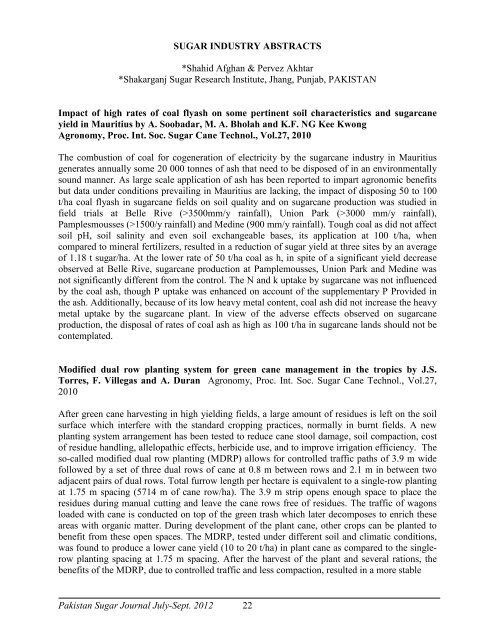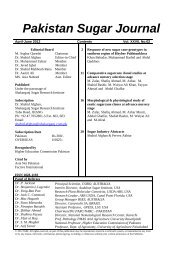Jul-Sep 2012 - Shakarganj
Jul-Sep 2012 - Shakarganj
Jul-Sep 2012 - Shakarganj
Create successful ePaper yourself
Turn your PDF publications into a flip-book with our unique Google optimized e-Paper software.
SUGAR INDUSTRY ABSTRACTS<br />
*Shahid Afghan & Pervez Akhtar<br />
*<strong>Shakarganj</strong> Sugar Research Institute, Jhang, Punjab, PAKISTAN<br />
Impact of high rates of coal flyash on some pertinent soil characteristics and sugarcane<br />
yield in Mauritius by A. Soobadar, M. A. Bholah and K.F. NG Kee Kwong<br />
Agronomy, Proc. Int. Soc. Sugar Cane Technol., Vol.27, 2010<br />
The combustion of coal for cogeneration of electricity by the sugarcane industry in Mauritius<br />
generates annually some 20 000 tonnes of ash that need to be disposed of in an environmentally<br />
sound manner. As large scale application of ash has been reported to impart agronomic benefits<br />
but data under conditions prevailing in Mauritius are lacking, the impact of disposing 50 to 100<br />
t/ha coal flyash in sugarcane fields on soil quality and on sugarcane production was studied in<br />
field trials at Belle Rive (>3500mm/y rainfall), Union Park (>3000 mm/y rainfall),<br />
Pamplesmousses (>1500/y rainfall) and Medine (900 mm/y rainfall). Tough coal as did not affect<br />
soil pH, soil salinity and even soil exchangeable bases, its application at 100 t/ha, when<br />
compared to mineral fertilizers, resulted in a reduction of sugar yield at three sites by an average<br />
of 1.18 t sugar/ha. At the lower rate of 50 t/ha coal as h, in spite of a significant yield decrease<br />
observed at Belle Rive, sugarcane production at Pamplemousses, Union Park and Medine was<br />
not significantly different from the control. The N and k uptake by sugarcane was not influenced<br />
by the coal ash, though P uptake was enhanced on account of the supplementary P Provided in<br />
the ash. Additionally, because of its low heavy metal content, coal ash did not increase the heavy<br />
metal uptake by the sugarcane plant. In view of the adverse effects observed on sugarcane<br />
production, the disposal of rates of coal ash as high as 100 t/ha in sugarcane lands should not be<br />
contemplated.<br />
Modified dual row planting system for green cane management in the tropics by J.S.<br />
Torres, F. Villegas and A. Duran Agronomy, Proc. Int. Soc. Sugar Cane Technol., Vol.27,<br />
2010<br />
After green cane harvesting in high yielding fields, a large amount of residues is left on the soil<br />
surface which interfere with the standard cropping practices, normally in burnt fields. A new<br />
planting system arrangement has been tested to reduce cane stool damage, soil compaction, cost<br />
of residue handling, allelopathic effects, herbicide use, and to improve irrigation efficiency. The<br />
so-called modified dual row planting (MDRP) allows for controlled traffic paths of 3.9 m wide<br />
followed by a set of three dual rows of cane at 0.8 m between rows and 2.1 m in between two<br />
adjacent pairs of dual rows. Total furrow length per hectare is equivalent to a single-row planting<br />
at 1.75 m spacing (5714 m of cane row/ha). The 3.9 m strip opens enough space to place the<br />
residues during manual cutting and leave the cane rows free of residues. The traffic of wagons<br />
loaded with cane is conducted on top of the green trash which later decomposes to enrich these<br />
areas with organic matter. During development of the plant cane, other crops can be planted to<br />
benefit from these open spaces. The MDRP, tested under different soil and climatic conditions,<br />
was found to produce a lower cane yield (10 to 20 t/ha) in plant cane as compared to the singlerow<br />
planting spacing at 1.75 m spacing. After the harvest of the plant and several rations, the<br />
benefits of the MDRP, due to controlled traffic and less compaction, resulted in a more stable<br />
Pakistan Sugar Journal <strong>Jul</strong>y-<strong>Sep</strong>t. <strong>2012</strong> 22






